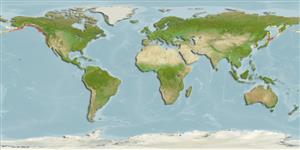>
Perciformes/Zoarcoidei (Eelpouts and pricklebacks) >
Scytalinidae (Graveldivers)
Etymology: Scytalina: Greek, skytale, -es = branch; cylindrical piece of wood used by Spartan army, with a paper tied around it containing orders or comunnications from the courts. It is also a kind of fish (Ref. 45335).
More on authors: Jordan & Gilbert.
Environment: milieu / climate zone / depth range / distribution range
Ekologi
marina bottenlevande. Temperate
Eastern Pacific: Bering Sea coast of Alaska to Diablo Cove, central California, USA.
Size / Vikt / Age
Maturity: Lm ? range ? - ? cm
Max length : 15.0 cm TL hane/ej könsbestämd; (Ref. 2850)
Short description
Bestämningsnycklar | Morfologi | Morfometri
Taggstrålar i ryggfenan (totalt) : 0; Mjukstrålar i ryggfenan (totalt) : 41 - 51; Taggstrålar i analfenan: 0; Mjukstrålar i analfenan: 36 - 41. Caudal rounded. Pectorals small.
Found in rocky areas, tide pools and off beaches (Ref. 2850). Burrows in loose gravel and sand or among broken shells on the bottom (Ref. 2850). May not utilize the intertidal zone for reproductive and recruitment purposes (Ref. 56899).
Life cycle and mating behavior
Könsmognad | Reproduktion | Lek | Ägg | Fecundity | Larver
Eschmeyer, W.N., E.S. Herald and H. Hammann, 1983. A field guide to Pacific coast fishes of North America. Boston (MA, USA): Houghton Mifflin Company. xii+336 p. (Ref. 2850)
IUCN Red List Status (Ref. 130435: Version 2024-2)
Threat to humans
Harmless
Human uses
Verktyg
Special reports
Download XML
Internet-källor
Estimates based on models
Preferred temperature (Ref.
123201): 5.7 - 14.8, mean 9.8 °C (based on 220 cells).
Phylogenetic diversity index (Ref.
82804): PD
50 = 1.5000 [Uniqueness, from 0.5 = low to 2.0 = high].
Bayesian length-weight: a=0.00389 (0.00180 - 0.00842), b=3.12 (2.94 - 3.30), in cm total length, based on all LWR estimates for this body shape (Ref.
93245).
Trofisk nivå (Ref.
69278): 3.3 ±0.5 se; based on diet studies.
Fishing Vulnerability (Ref.
59153): Low vulnerability (10 of 100).
